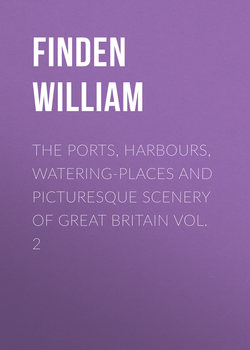Читать книгу The Ports, Harbours, Watering-places and Picturesque Scenery of Great Britain Vol. 2 - Finden William - Страница 14
EAGLE TOWER, CAERNARVON CASTLE
ОглавлениеCaernarvon Castle, of which the Engraving annexed presents so faithful and striking a resemblance, is a subject of no ordinary interest: it generally engrosses the attention of all strangers in these parts, and is, in every sense, one of the noblest specimens of castellated architecture in existence. Like so many others of similar design and execution, this fortress owes its origin to the policy of Edward the First, who built it, according to contemporary history, by appropriating the revenues of the See of York, then vacant, to the purposes of warlike enterprise and ambition. The town is understood to have arisen under the same auspices. The Castle defends it on the south by means of a narrow, deep moat in front. In its west wall are three circular towers, with two others on either side, and a narrow gate or entrance, over which is placed a bare-headed figure with flowing locks, – the statue of the founder, – holding in his left hand a sword, which he draws with his right hand, – or rather, perhaps, is returning to its scabbard, in allusion to the subjugation of the Welsh, – and a defaced shield under his feet. This gate leads to a narrow, oblong court. At the west end is a polygon, or many-sided tower, with three others of hexagonal form above, and eagles sculptured on the battlements, from which it received the name, preserved in the Engraving, of the "Eagle Tower." It is a noble structure, having ten sides, and a staircase of three hundred steps to the battlements. In this tower is the birth-chamber of Edward the Second, – the first Prince of Wales,1 – whose nativity, on the 25th of April, 1284, was an humiliating epoch to the spirit of Cambrian freedom. The room measures only eleven feet by seven, – dimensions little in accordance with the importance attached to that event, – but still in some measure characteristic of the fortunes of the royal heir, who, after an eventful reign, was destined at last to perish by a horrible death in the dungeon-room of Berkeley Castle. Adjoining this chamber is a semicircular apartment, traditionally described as the King's Nursery.
The Castle and the court which it encloses are very nearly a mile in circumference. From the outside, twelve towers are seen; out of which, as observed in those of Conway Castle, issue several smaller angular turrets, which, relieved against the horizon, produce a very picturesque effect. A gateway on the south side of the Castle is called the Queen's Gate, from the circumstance of Queen Eleanor having entered the fortress through this gate, by a temporary bridge erected for the occasion.
Our limits do not permit us to indulge in more minute description of this vast and imposing fortress, which, from the state of repair in which it is still kept, may brave the changes of season and the fury of the elements for many generations to come. Externally it is still entire, and challenges the admiration of all who have the least taste for what is sublime and striking in architecture. The castle-walls are still washed by the sea on the north and west, as they formerly were on the south. Founded upon a rock, and occupying so strong a position, it might well have been considered impregnable in the absence of gunpowder. Immense as the structure appears, it is said to have been built within the short space of twelve months; a fact which would appear incredible, did we not reflect that in those days of bitter vassalage the will of the sovereign was a law that could not be transgressed without certain destruction to the offenders. If a work was considered impracticable, or of doubtful accomplishment, all hesitation was removed – all difficulties cancelled – by these expressive words, Le Roi l'a voulu! And under the more than magical influence of this laconic phrase, the "towery fortress" of Caernarvon may have sprung into sudden existence.
1
The origin of the motto Ich Dien – I serve – is generally attributed to Edward the Black Prince who, in leading the vanguard of his army to the battle of Cressy, slew John of Luxemburg, King of Bohemia, and then deplumed his helmet of those ostrich feathers which, in memory of this victory, became his cognisance, – sometimes using one feather, at others three, as appears on his seals and tomb, with scrolls containing this motto, Ich Dien. But the ancient arms of the princes of Wales, while they were independent sovereigns, were quarterly gules and or, four lions passant, counterchanged. The Charter of Edward the First to his son is dated March 24th, 1305, —i. e. when the Prince had attained his majority.
